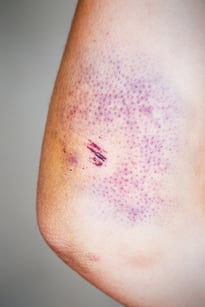One of the most common types of injuries that Chiropractors treat for patients is Soft Tissue Injuries. These types of injuries are so common because Soft Tissue is responsible for connecting, supporting, and surrounding the structure and functionality of the body, including our bone and organ structure.
Because of their involvement throughout the entire body, soft tissues can easily be exposed to injuries when a person is involved in an accident or over-exerts themselves.
Chiropractic Care is so effective at treating Soft Tissue Injuries because Chiropractors have been trained to treat conditions of the Musculoskeletal system, which includes Soft Tissue.
Chiropractic care is safe, an noninvasive treatment that works to heal the cause of the issue, not just mask the symptoms. Which means no medication for pain will be prescribed.
So how do Chiropractors treat Soft Tissue Injuries? Before we discuss the benefits of Chiropractic care for Soft Tissue Injuries, lets first discuss what exactly Soft Tissue and Soft Tissue Injuries are.
Article Table of Contents:
- What is Soft Tissue?
- Diagnosing a Soft Tissue Injury
- Symptoms of a Soft Tissue Injury
- How the Body Reacts to Soft-Tissue Injuries
- How Chiropractors Treat Soft Tissue Injuries
What is Soft Tissue?
As previously stated, Soft Tissue is vital to the functionality of the body because it provides structure and stability to our skeletal and organ system.
So what components of the body are considered Soft Tissue? All of the following make up the body's Soft Tissue:
- Muscles - muscles are made up of fibers that shorten and lengthen to produce movement of a joint. Muscles are attached to bone by tendons.
- Tendons - these are a flexible fibrous tissue that function as the connection between bone and muscle.
- Ligaments - flexible and tough fibrous connective tissue that connect bones and cartilage and are responsible for maintaining the joints in the body.
- Bones - the pieces of hard tissue composed of calcium phosphate and calcium carbonate that make up the skeleton.
- Nerves - fibers that transmit impulses of sensation throughout the body, including the brain, spinal cord, and organs.
- Cartilage - firm, whitish, flexible connective tissue found throughout the body, including the joints. A large percentage of the body's cartilage is replaced by bone as a person grows out of infa
ncy.

Any or all of the above types of Soft Tissue can become injured in an incident such as a Car Accident in various degrees.
Depending on the severity and location of the Soft Tissue Injury, a patient may receive one of the following diagnosis':
- Sprain
- Strain
- Contusion (Bruising)
- Tendonitis
- Tears
- Whiplash
In order to determine the extent of the Soft Tissue injury, a physician will need to examine the patient to determine a diagnosis.
Diagnosing a Soft Tissue Injury
Soft Tissue injuries can be difficult to diagnose because they do not always present symptoms immediately and do not show up on some diagnostic tests such as X-Rays.
If you have been involved in an accident, there are certain symptoms that you can watch out for if you think you may have suffered a Soft Tissue Injury.
Symptoms of a Soft Tissue Injury
- Pain - can be mild or acute, and may also not be felt until hours or even days after an injury actually occurred.
- Swelling/Inflammation - Swelling and inflammation is the bodies first reaction to attempting to heal from a soft tissue injury and can include redness and warmth.
- Discoloration/Bruising - Bruising occurs after an impact to soft tissue that results in capillaries breaking open and causing red blood cells to leak out.
- Stiffness - Stiffness often occurs due to inflammation as the body tries to repair the damaged soft tissue.
- Loss of function - Loss of function is mostly due to restricted movement due to inflammation as well as weakness in the soft tissue due to a tear or other damage.
How the Body Reacts to Soft-Tissue Injuries
When a person suffers a Soft Tissue Injury, the body begins to go through its self-healing process. This process includes three main phases, the Inflammatory Stage, the Repair Stage, and the Remodeling Stage.
Inflammatory Stage
 Usually lasting approximately 5 days, the Inflammatory stage is the first stage of the body's natural healing process from a Soft Tissue Injury. During this stage, symptoms include pain, swelling, redness, and warmth.
Usually lasting approximately 5 days, the Inflammatory stage is the first stage of the body's natural healing process from a Soft Tissue Injury. During this stage, symptoms include pain, swelling, redness, and warmth.
These symptoms are the body's way of limiting the functioning ability of the damaged tissue in order to protect it so it can heal.
During the Inflammation stage, the body also releases chemicals that lead to the next stage of the healing process, the Repair Stage.
Often times, doctors and Chiropractors will recommend that patients follow the RICE system during inflammation, which stands for Rest, Ice, Compression, and Elevation.
Repair Stage
During the Repair stage, the body sets out to remove the now dead tissue and debris and replace it with new tissue.
As this new tissue forms and takes the place of the old tissue, the injured area will still have limited mobility and strength.
This is mainly due to the new tissue consisting of Scar Tissue, which is not as strong or organized as the healthy tissue it is replacing.
However, as the repair stage progresses, strength and mobility should also gradually increase. This process lasts much longer than the inflammatory stage, usually taking weeks to complete.
Remodeling Stage
Once your body has gone through the Inflammation and Repair stage, the next stage is the Remodeling stage, which begins once enough Scar Tissue has formed that can be used to correct the injured area.
The goal of the Remodeling Stage is to manipulate the newly formed Scar Tissue into fully functioning, healthy Soft Tissue.
Depending on the severity of the injury that occurred, this stage can last anywhere from 1-18 months.
During this phase of recovery, it is vital that the individual helps their body heal by implementing exercises, stretching and other stimuli so that the functionality of the tissue improves.
If a person fails to help the healing process with therapy and stimulation, it can lead to continued pain, reduced mobility and weakness in the affected area.
How Chiropractors Treat Soft Tissue Injuries

Chiropractic Care is a popular treatment option for Soft Tissue Injuries because they are experts when it comes to the Musculoskeletal system.
Our Florida Chiropractors have years of experience and training in understanding the functionality of the Soft Tissue in the body and therefore know what to look for when diagnosing an injury and developing a treatment program.
Depending on the diagnosis that the Chiropractic Doctor arrives at, the individualized treatment program may include any of the following types of treatment:
- Chiropractic Adjustment
- Mobilization
- Exercise Therapy
- Electrical Muscle Stimulation
- Spinal Traction
- Massage Therapy
- Stretching
- Nutrition and/or Dietary Changes
As previously stated, the type of treatment that a patient receives for a Soft Tissue Injury depends on the diagnosis.
Once the diagnosis is determined, the Chiropractor will decide what the best course of treatment for the patient will be and begin said treatment.
If you believe that you have suffered a Soft Tissue Injury, scheduling a Free Consultation with an experienced Chiropractor may be a good idea.
Schedule your consultation with one of the Soft Tissue Injury Chiropractors at Florida Spine and Injury today and make sure that you give yourself the best chance at making a full physical recovery.
-1.png?width=120&height=108&name=Ethos%20Health%20Group%2c%20(1)-1.png)




Leave a Comment